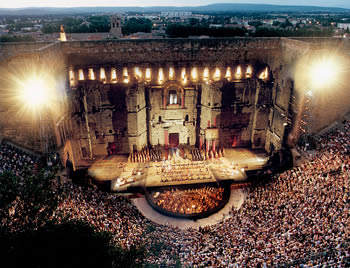Verdi, Il trovatore:
Soloists of Les Chorégies d'Orange, chorus from
regional companies in Southern France, Orchestre
National de France, Orange, France. 28.7.2007
(MM)
Conductor: Gianandrea Noseda
Producer: Charles Roubaud
Lighting: Vladimir Lukasevich
Stage designer: Jean-Noël Lavesvre
Costumes: Katia Duflot
Video Show: Gilles Papain
Leonora: Susan Neves
Azucena: Larrissa Diadkova
Ines: Marie-Paule Dotti
Manrico: Roberto Alagna
Il Conte di Luna: Seng-Hyoun Ko
Ferrando Arutjun: Kotchinian
Ruiz Sébastien :Guèze
Un Vecchio Zingaro: David Bizic
Un Messagero: Jean-François Borras

The Orange Arena: Picture © Les Chorégies d'Orange
Orange's magnificent Théâtre Antique was packed to
the gills partly because France's glamour tenor
Roberto Alagna was le trouvère, reputedly
one of his best roles. And Les Chorégies d'Orange
successfully met the challenge of assembling a
supporting cast for this dashing, now forty-four
year-old tenorissimo with American soprano Susan
Neves as Leonora, an Azucena from Russian mezzo
Larrissa Diadkova, and South Korean baritone
Seng-Hyoun Ko as Conte di Luna.
Make no mistake, Il trovatore is not about
infanticide and bloody revenge: it is about
singing. Nonetheless a case can be made for
casting a handsome trouvère, and in Orange
his gypsy mother exuded an elegance of bearing to
match such tenorial flash, though of course she is
not really his mother and is really a hag.
Verisimilitude was completely lost though with the
pairing of this trouvère's cocky Sicilian
swagger with the ballsy swagger of his somewhat
shorter Korean brother. But this was
international opera at its best nonetheless,
meaning that the casting ultimately did make
dramatic sense where it matters most for Il
Trovatore - in the voices.
The venue is huge, dominated by a massive back
wall with some small architectural detail
remaining. Because the stage may be as much as 60
meters wide it reads as a massive horizontal
space, clearly impossible to transform
scenically. Thus the Orange Roman theater gave
definition to minimalist staging long before this
late twentieth century style became accepted by
opera audiences elsewhere.
So it was staging as usual, this time by Charles
Roubaud who has proven himself a fine minimalist
in many productions hereabouts, most recently for
Die Walküre in Marseille. As usual,
massive armies poured in from the huge side
openings, clashed as necessary in the middle and
flowed out the other side, here the Aragon
soldiers and their officers in tailored pale blue
gray uniforms, there the Biscay rebels without
uniforms and mostly in black. By contrast, nuns
flowed in, circled and flowed out of a hidden
upstage opening, white habits billowing. Costumes
are everything at Orange and costumer Katia Duflot
rose to the occasion providing something akin to
operatic haute couture, never allowing a
level of elegance to falter even when clothing
Azucena.
The principal singers were kept right where they
belonged - downstage center – with le trouvère
and his elegant gypsy stepmother in chic, close
fitting Spanish black. Leonora on the other hand,
was covered in yards of a gray-blue gossamer
fabric able to be caught by the slightest of
breezes in this open-air theatre and creating an
impressively dynamic presence. Mme. Neves remained
immobile for her fourth act arias, allowing the
movements of her costume to amplify her
pianissimos and to brighten the fires of these
showpieces. Nine thousand people, maybe ten,
roared their appreciation.
Downstage center to be sure, and in obvious
rapport with conductor Gianandrea Noseda, this
fine cast delivered great arias and ensembles of
Verdi's most melodious opera on the level of what
seemed near perfection. Though when not communing
with his divas and divos, this conducting star
indulged in lugubrious, self-important tempos and
sometimes with the sound of the scores of
chorus voices - unlikely as that may seem, for
tight ensemble has been the rule rather than the
exception at Orange over the years.
A stepped structure upstage gave access the large
door centered in the back wall, a point of
dramatic entrance and exit. It was here that
director Roubaud positioned Alagna, his sword
thrust high, to deliver the critically incorrect
high "C" of di quella pira. Even though
the duration of this high note was kept tastefully
brief it evoked a huge and prolongedovation, for
the whole of which Alagna held this hyper-dramatic
pose.
The most striking visual element of this
production was its use of projection and video,
the work of Gilles Papain. For once, the 'cheap
effect' stigma of such tricks was overcome,
perhaps because projecting video images of such
magnitude (an estimated 40 by 60 meters) could
hardly be cheap, and images of such a size can
never be less than imposing. Inspired by the
breezes - and sometimes the winds that play around
the uncovered theater - these huge, artful video
images, always in black and white, created a
visual energy for this massive space that
complimented its high musical energy.
The shadow of the single branch representing
Leonora's garden seemed to move with the evening
air too, battle scene flags beat urgently to the
hints of a Mistral wind and a huge raft of votive
candles flickered dimly in the monastery. Finally
a pyre ignited; at first a red slash appeared
across the width of the stage, then a huge,
intense, red flame burst onto the wall into which
Azucena shouted her revenge.
This final image, playing well beyond the words,
but certainly within the intention of Verdi's
libretto, was driven on with inspired musical
brilliance by conductor Noseda, creating the kind
of spine tingling finale that occurs every so
often in Orange, and keeps us going back for more.
Michael Milenski
Michael Milenski's website,
www.capsuropera.com
tracks opera houses from Genoa across Southern
France to Barcelona.
Back
to the Top
Back to the Index Page

